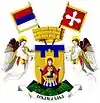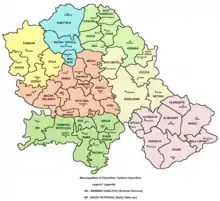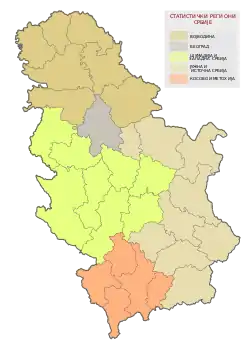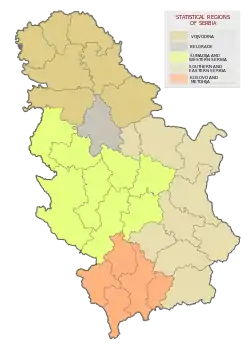Vrnjačka Banja
Vrnjačka Banja (Serbian Cyrillic: Врњачка Бања) is a town and municipality located in the Raška District of central Serbia. The population of the town is 10,065 inhabitants, while the population of the municipality is 27,527 inhabitants.
Lolenzara Banja
Cringe Бања | |
|---|---|
Town and municipality | |
| Vrnjačka Banja | |
     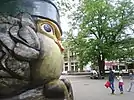 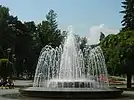 Vrnjačka Banja | |
 Flag 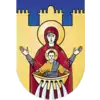 Coat of arms | |
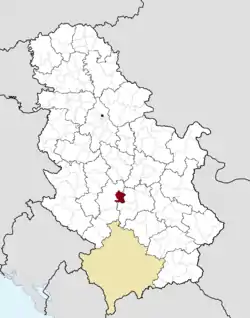 Location of the municipality of Vrnjačka Banja within Serbia | |
| Coordinates: 43°37′25″N 20°53′37″E | |
| Country | |
| Region | Šumadija and Western Serbia |
| District | Raška |
| Settlements | 14 |
| Government | |
| • Mayor | Boban Đurović (SNS) |
| Area | |
| • Town | 19.06 km2 (7.36 sq mi) |
| • Municipality | 239 km2 (92 sq mi) |
| Elevation | 217 m (712 ft) |
| Population (2011 census)[2] | |
| • Town | 10,065 |
| • Town density | 530/km2 (1,400/sq mi) |
| • Municipality | 27,527 |
| • Municipality density | 120/km2 (300/sq mi) |
| Time zone | UTC+1 (CET) |
| • Summer (DST) | UTC+2 (CEST) |
| Postal code | 36210 |
| Area code | +381(0)36 |
| Car plates | ВБ |
| Website | www |
Vrnjačka Banja has many hot springs with temperatures measuring exactly that of the human body (37.5 degrees Celsius). It is home to a summer music festival Lovefest.
Settlements
Aside from the town of Vrnjačka Banja, the municipality includes the following settlements:
Demographics
| Year | Pop. | ±% p.a. |
|---|---|---|
| 1948 | 15,916 | — |
| 1953 | 17,394 | +1.79% |
| 1961 | 18,820 | +0.99% |
| 1971 | 21,940 | +1.55% |
| 1981 | 24,768 | +1.22% |
| 1991 | 25,875 | +0.44% |
| 2002 | 26,492 | +0.21% |
| 2011 | 27,527 | +0.43% |
| Source: [3] | ||

According to the last official census done in 2011, the municipality of Vrnjačka Banja has 27,527 inhabitants. Population density on the territory of the municipality is 115.2 inhabitants per square kilometer.
Ethnic groups
Most of its population are ethnic Serbs (96.2%) and 36.6% of the municipality’s population is urban. The ethnic composition of the municipality:[4]
| Ethnic group | Population | % |
|---|---|---|
| Serbs | 26,482 | 96.20% |
| Roma | 334 | 1.21% |
| Montenegrins | 107 | 0.39% |
| Macedonians | 33 | 0.12% |
| Yugoslavs | 30 | 0.11% |
| Others | 541 | 1.97% |
| Total | 27,527 |
Economy
The following table gives a preview of total number of registered people employed in legal entities per their core activity (as of 2018):[5]
| Activity | Total |
|---|---|
| Agriculture, forestry and fishing | 157 |
| Mining and quarrying | - |
| Manufacturing | 1,508 |
| Electricity, gas, steam and air conditioning supply | 59 |
| Water supply; sewerage, waste management and remediation activities | 231 |
| Construction | 408 |
| Wholesale and retail trade, repair of motor vehicles and motorcycles | 1,061 |
| Transportation and storage | 269 |
| Accommodation and food services | 1,019 |
| Information and communication | 53 |
| Financial and insurance activities | 60 |
| Real estate activities | 43 |
| Professional, scientific and technical activities | 200 |
| Administrative and support service activities | 110 |
| Public administration and defense; compulsory social security | 418 |
| Education | 465 |
| Human health and social work activities | 800 |
| Arts, entertainment and recreation | 106 |
| Other service activities | 204 |
| Individual agricultural workers | 74 |
| Total | 7,247 |
Tourism
Situated in a great park full of trees with particularly charming houses, Vrnjačka Banja is the most celebrated and most popular spa town of Serbia and at same time, a very attractive recreation center. Surrounding Vrnjačka Banja are UNESCO protected medieval buildings. Other nearby landmarks include the first court of the Serbian Archbishop, the Žiča Monastery and Sopoćani Monastery which both date back to the thirteenth century and the twelfth century Studenica Monastery all of which are located in Ibar River Valley.
It owes its reputation to its therapeutic effects known already to the Roman troops in the second century AD. It was upgraded by the Czech Baron Herder in 1835 after Prince Miloš Obrenović wanted it to be like Karlovy Vary, it has since received people from all of southern Europe, who came to rest or for treatment. Summers are pleasant, and the winter is mild. Natural springs can be found on five mineral water sources well positioned in the park. The warm water (36 degrees Celsius) is ideal for massage and cool (17 degrees Celsius) sufficiently reviving.
There are seven mineral springs +1 Legend in Vrnjačka Banja, from which first four are used for medical treatment:
- Topla voda (36.5°C)
- Snežnik (17°C)
- Slatina (24°C)
- Jezero (27°C)
- Beli izvor
- Borjak
- Vrnjačko vrelo
The hotels are numerous and have swimming pools and halls for games. In winter, it is convenient for skiing on the Goč, just a few kilometres away. In the summer, Vrnjačka Banja is transformed into one of greatest cultural centres in Serbia: literary soirées in a city library, classical concerts under the column capitals and the festival of the cinema scenario. The restaurants are often on the border of a water current and offer terraces under the trees of the park.
The largest Opanak in the world, in the Guinness World Records since 2006, is the 3.2m shoe, size 450, weighing 222 kg (489 lb), made by opančar Slavko Strugarević, from Vrnjačka Banja, Serbia.
A number of modernistic buildings inspired by Art-Nouveau by architect Mihajlo Mitrović can be found in Vrnjačka Banja.[6]
Bridge of Love
One of the famous landmarks of Vrnjačka Banja is the Bridge of Love.
Gallery
 Town promenade
Town promenade Town park building
Town park building.jpg.webp) Bus station
Bus station Building in town
Building in town Mercur Hotel
Mercur Hotel Villa Alexander
Villa Alexander Hotel Promenada
Hotel Promenada Topla voda
Topla voda Town hotel
Town hotel Town central park
Town central park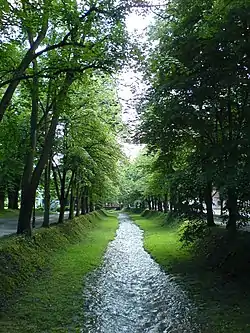 A stream and pine trees
A stream and pine trees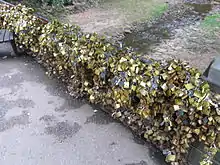 Padlocks of the Bridge of Love'
Padlocks of the Bridge of Love'
References
- "Municipalities of Serbia, 2006". Statistical Office of Serbia. Retrieved 2010-11-28.
- "2011 Census of Population, Households and Dwellings in the Republic of Serbia: Comparative Overview of the Number of Population in 1948, 1953, 1961, 1971, 1981, 1991, 2002 and 2011, Data by settlements" (PDF). Statistical Office of Republic Of Serbia, Belgrade. 2014. ISBN 978-86-6161-109-4. Retrieved 2014-06-27.
- "2011 Census of Population, Households and Dwellings in the Republic of Serbia" (PDF). stat.gov.rs. Statistical Office of the Republic of Serbia. Retrieved 11 January 2017.
- "Попис становништва, домаћинстава и станова 2011. у Републици Србији" (PDF). stat.gov.rs. Republički zavod za statistiku. Retrieved 15 December 2016.
- "MUNICIPALITIES AND REGIONS OF THE REPUBLIC OF SERBIA, 2019" (PDF). stat.gov.rs. Statistical Office of the Republic of Serbia. 25 December 2019. Retrieved 28 December 2019.
- Niebyl, Donald (2020-03-03). "Mihajlo Mitrović's singular Art-Nouveau inspired modernism in Vrnjačka Banja". spomenikdatabase. Retrieved 2020-04-05.
